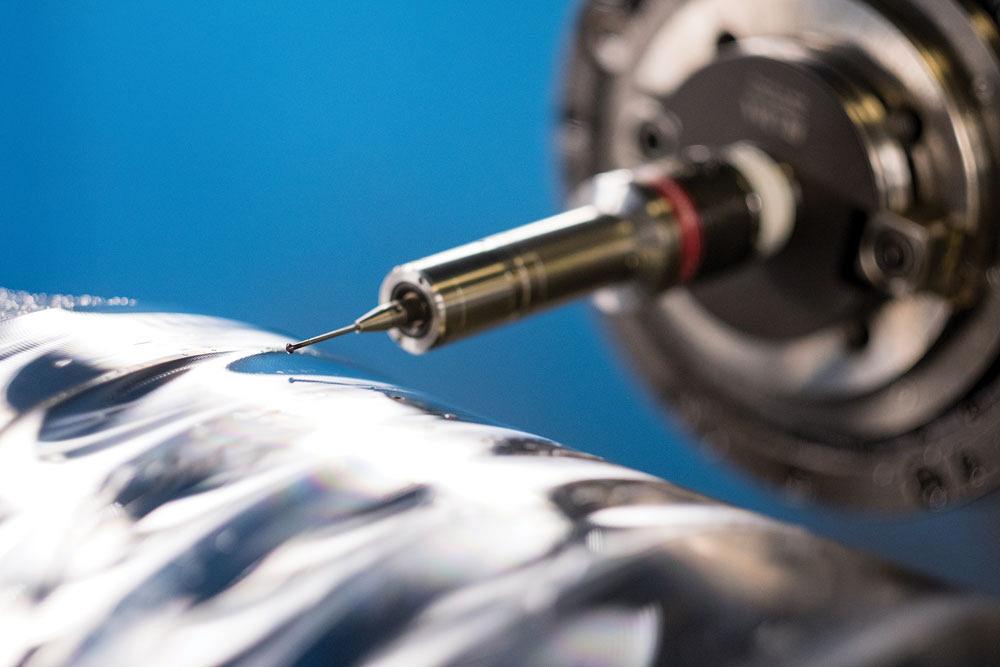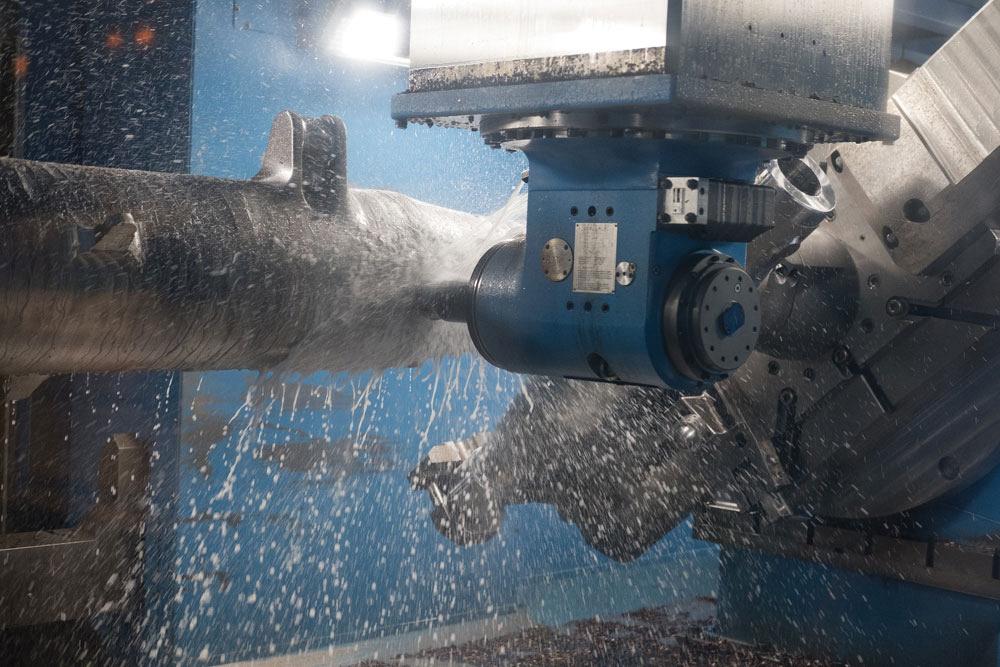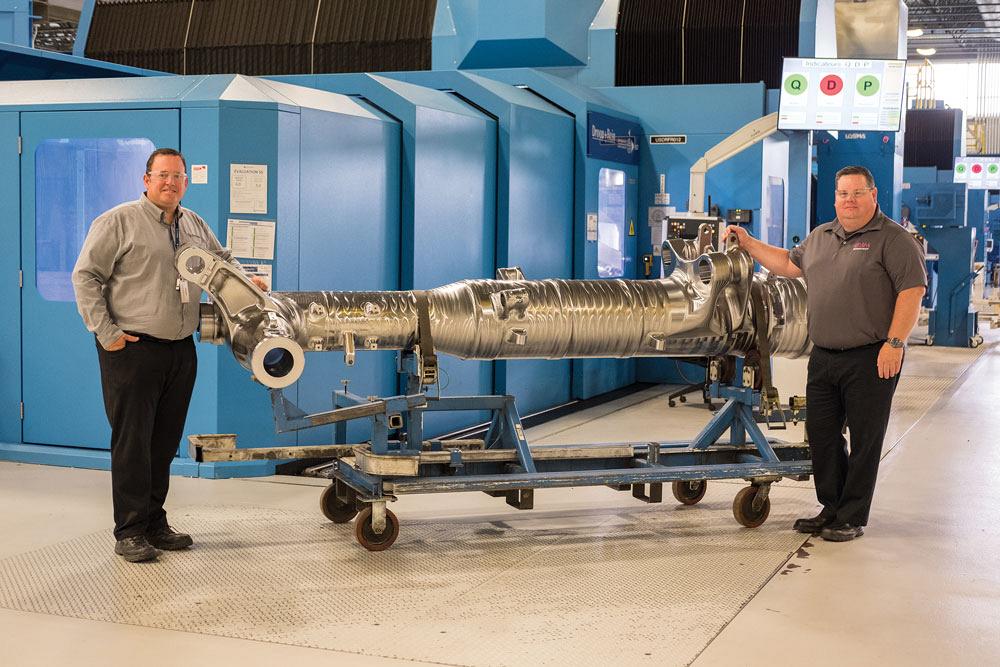- FMA
- The Fabricator
- FABTECH
- Canadian Metalworking
A measure of success at Safran Landing Systems
Aircraft landing systems manufacturer uses automated measurements to reduce inspection time, eliminate human error
- By Canadian Metalworking
- September 20, 2021
- Article
- Measurement

The TC63-RG roughness gauge is supplied with a special stylus. Unlike with manual measuring devices, measuring movements are possible along two axes, which is useful for measuring rounded shapes.
Situation
Safran Landing Systems is the world’s largest manufacturer of aircraft landing systems. At its plant in Mirabel, just north of Montreal, the company builds landing gear for both Airbus and Boeing commercial airliners, the mainstay of the global aviation industry. Every day these aerospace assemblies get hundreds of commercial airline flights into the air and take them safely to their destinations.
Because the aerospace sector is such a technically demanding field, Safran must prove time and again that it can meet any challenges its customers present. One of the ways it does this is by using the most advanced technological systems possible to support its manufacturing and data gathering. In fact, the company has an entire department dedicated to Industry 4.0, which works constantly to improve how it collects and uses the massive amounts of data generated during manufacturing. The company also reinvests about 7 per cent of its revenue in R&D.
To help ensure that every assembly that leaves its plant meets stringent customer requirements, Safran has been using Blum-Novotest, Cambridge, Ont., measuring equipment for years. This includes the use of Blum lasers to measure and check tools, monitoring length, radius, diameter, and other parameters to prevent crashes and track tool wear.
The landing gear manufacturer also has relied on the Blum TC63 CNC touch probe to check the precision of workpiece measurement for several years now.
Recently Safran needed a tool to monitor surface finish, an especially critical parameter in one of the highly engineered systems it manufactures. The company manufactures the main component of the landing gear in its Mirabel facility. Overseeing the manufacturing process is the NC co-ordinator, Shawn Page.
“It’s a machining-intensive process, and our customers are very demanding when it comes to precision,” said Page. “Surface finish is critical.”
When the Mirabel plant was expanded to handle massive new landing gear contracts from Airbus and Boeing, it needed to ramp up capacity quickly while maintaining the highest standards of accuracy and repeatability by introducing more automation into its parts inspection process.
The primary component of each landing gear system starts out as a massive forging, some of them weighing up to 8 tons. Each forging is mounted on a CNC machining centre that uses heavy cutters to rough the shape, imparting a rough finish that brings the workpiece close enough to final configuration that only a thin layer of metal needs to be removed to achieve the final finish. A second pass removes that layer, bringing the workpiece to the required final finish.
Resolution
Then it’s time to check the part’s surface finish. For that Safran chose Blum’s TC64-RG roughness gauge.
This roughness gauge is used to conduct a detailed surface inspection of the finished part. Any irregularities detected at this stage will be minor enough that they can be removed by a final polishing process.

The main component of each landing system is a massive forged piece that can weigh up to 8 tons. Despite the cooling agent in the working area, the surface roughness gauge still can be used.
However, Safran’s processes needed to become more automated to handle its increased workload, reduce its manual processes, and maintain and even improve its high standards of quality control. Surface finish inspection was one area where Page needed to cut time out of the process, improve accuracy, and increase the number of workpiece surfaces under inspection. And he had to do it with fewer operators. Page also wanted to increase the amount of data that was gathered during production and be able to feed that data back into the production process.
Because the surface inspection operation takes place with the finished part still mounted on the machining centre, the process cut into both the machine’s cycle time and its operator’s time.
Before switching to the new roughness gauge, 10 areas on each part needed to be inspected, and the process took around 45 minutes. And, because the accuracy of measurement depended on an operator placing a hand-held measuring device correctly, the possibility of human error entering the process was considerable. The amount of time required also meant Page was forced to inspect a limited number of surfaces.
When Jamie King, Canadian regional manager for Blum-Novotest, introduced the new roughness gauge to Page and his team, they were intrigued by its potential to optimize their surface inspection process.
“It had the right potential for us, and we wanted to look into it in more detail,” said Page.
After several on-site demonstrations, King arranged a visit for Page to tour Blum’s headquarters in Ravensburg, Germany, to get a closer look. After witnessing the possibilities of the roughness gauge firsthand, the company decided it was the right choice for its production.
King took an active role as a resource for Safran throughout the switchover. This process included iterative development of custom software to integrate the parts measurement process with Safran’s back-end IT systems. With special funding from their parent company, The Safran Group, to develop the system, Page and his team worked closely with Blum to develop the final product.
“It was very much a partnership to get where we are today,” said King.
Page hopes the addition of the gauge will help eliminate the possibility of human error in the measuring process. He also anticipates it will reduce the amount of time required for inspection, with the time savings used to do an even more robust parts check and inspect more surfaces than was possible before installing the gauge. It’s also now possible to check every tool at the beginning and end of each machining pass so that wear and deviation can be spotted and corrected well before they become a serious problem.
In the future, Page plans to migrate this technology to other machines and processes at Safran.

Shawn Page (left), Safran’s NC co-ordinator, together with Jamie King, Canadian regional sales manager for Blum-Novotest, stand next to a fully machined landing system part.
Blum-Novotest, www.blum-novotest.us
Safran Landing Systems, www.safran-landing-systems.com
About the Author
subscribe now


Keep up to date with the latest news, events, and technology for all things metal from our pair of monthly magazines written specifically for Canadian manufacturers!
Start Your Free Subscription- Industry Events
Automate 2024
- May 6 - 9, 2024
- Chicago, IL
ANCA Open House
- May 7 - 8, 2024
- Wixom, MI
17th annual Joint Open House
- May 8 - 9, 2024
- Oakville and Mississauga, ON Canada
MME Saskatoon
- May 28, 2024
- Saskatoon, SK Canada
CME's Health & Safety Symposium for Manufacturers
- May 29, 2024
- Mississauga, ON Canada





















